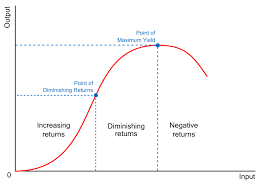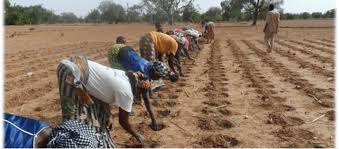In the production process, inputs are transformed into outputs. Whatever is introduced into the production process emerges as output. Consequently, there exists a relationship between the input (resources used) and the output (the final product).
Generally, a function describes the relationship between variables. In production economics, the most fundamental relationship is between the factors of production and the product.
Read Also: Rabbit Reproduction: Pregnancy, Kindling, Sexing, and Weaning
Understanding the Law of Diminishing Returns

One of the most critical principles in economic analysis is the Law of Diminishing Returns. This law forms the foundation for marginal analysis, a powerful tool in economics. The Law of Diminishing Returns refers to the amount of additional output obtained as additional inputs of variable factors of production are added to a fixed set of other factors.
In its simplest form, it states that with one factor of production held constant, the additional output derived from each additional unit of a variable factor declines after a certain level of the variable factor has been used.
Diminishing Economic Returns in Agriculture
The principle of Diminishing Returns holds significant economic importance, as most factors of production and products have economic value. By converting physical data into monetary terms, diminishing economic returns become evident.
Comparing these returns with the associated costs helps determine whether production is profitable and identifies the level of production that maximizes returns.
Decision Rules for Profit Maximization
The Law of Diminishing Returns provides the basis for determining whether production is profitable and identifies the level of production that maximizes returns.
As shown in Table 1.3, the additional cost of producing an additional unit of output (Marginal Cost, MC) is approximately equal to the additional (marginal) value of the product (Marginal Value Product, MVP) at 50 kg of nitrogen. This is the point where profit is maximized, i.e., where MVP = MC (highlighted in Columns 6 and 13).
The exact quantity of nitrogen required to maximize profit lies between 50 and 60 kg per hectare, though closer to 50 kg. The corresponding quantity of output that maximizes profit is approximately 5670 kg of maize, with the exact quantity falling between 5670 and 6125 kg but closer to 5670 kg (see Column 11).
From a farm financial management perspective, every additional unit of input increases financial commitments. Each unit of input incurs additional financial costs, as inputs are not free. If inputs were free (i.e., the price of ( N = 0 )), the level of production would occur where Total Physical Product (TPP) peaks.
Read Also: Rabbit Health and Diseases and How to Minimize Major Stresses
The Principle of Marginalization in Agricultural Decision-Making

This principle describes the behavioral rule in the decision-making process of farms. Under perfect competition, short-run profits are maximized at the intersection of the Marginal Cost (MC) and Marginal Revenue (MR) curves.
This applies to the profit maximization process in the short run, assuming that temporal decisions are independent. The principle also implies profit maximization for farms in the long run.
Decision Rules Derived from the Principle of Marginalization
1. If MC < MR: Profits are not maximized; it is desirable for the farm to expand production in the short run.
2. If MC > MR: Profits will decrease; the farm should reduce its current level of production.
3. If MC = MR: Profit is maximized, and input application is at its optimal level.
Short-Run Cost Curves in Agricultural Production
1. SMC (Short-Run Marginal Cost Curve): Exhibits a positive slope and a rising trend.
2. SATC (Short-Run Average Total Cost Curve): Displays a ‘U’ shape.
3. MR (Marginal Revenue Curve): Has a slope of 0.
4. Xc: Represents optimal output.
5. BACD: Represents profit.
Do you have any questions, suggestions, or contributions? If so, please feel free to use the comment box below to share your thoughts. We also encourage you to kindly share this information with others who might benefit from it. Since we can’t reach everyone at once, we truly appreciate your help in spreading the word. Thank you so much for your support and for sharing!
Read Also: What You Need to Know About Home Waste Recycling
Frequently Asked Questions
We will update this section soon.

